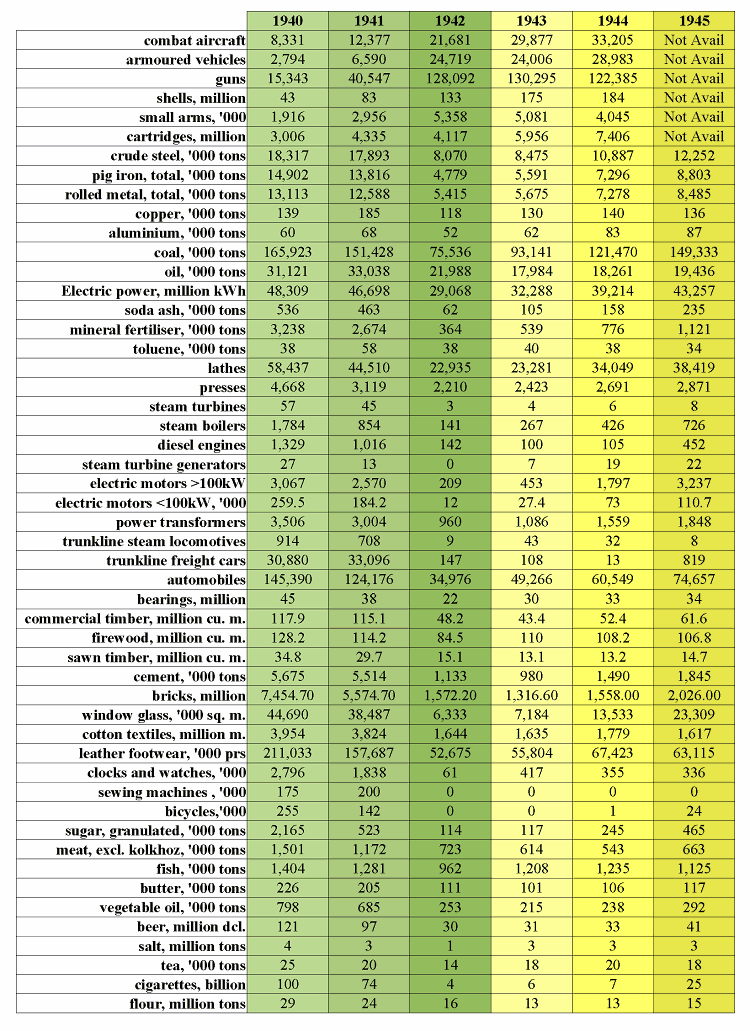
And here is the Resource output normalized with 1940 production levels as 1.0

Moderator: K. A. Pital









Remember, that the Soviet Union retained control over the black sea (or at least could contest it) well into the war, and had access to the Pacific via Vladviostock -- which led to an amusing turn of events -- Ships loaded with lend lease sailed right through Japanese waters to land at Vladviostock, to unload guns to kill nazis -- a nominal japanese ally.Thanas wrote:I was wondering why fishing remained at such a high level - maybe Stas can answer this?


That makes a lot of sense, I had completely forgotten about the Caspian sea.Sea Skimmer wrote:In the fishing, its worth considering that a large portion of Soviet fish would have come from the Caspian Sea, which would have never been directly disrupted either. Since the Soviets had a major food shortage overall it is likely fishing was intensified in the far east and Caspian Sea during the war.
The figures might not have the Baltic countries included (annexed in 1940) and even if they are, I doubt the Germans had enough resources after 1942 to hunt fishing boats on the Barents Sea, which would have made fishing from Murmansk at least partially feasible from 1943 on. Then there was the White Sea, which was never under German control or surveillance. Caspian Sea was already mentioned, but the Aral Sea was also very good for fishing before the ill-conceived Soviet irrigation projects that nearly dried it.Thanas wrote:Yes, but I would imagine the loss of the fishing in the baltic sea and the significant loss of the black sea territory would have had more of an impact. Likewise with fishing from Murmansk (u-boats, bombers).

Condors didn't fly missions like that and had gotten entirely out of making direct attacks by 1942. The anti shipping and recon work in Northern Norway was done with the He115 seaplane while it lasted, along with Ju88 and He111 torpedo bombers. It had a major concentration of Do217s for a time as well; probably the only place Germany ever massed that aircraft.PeZook wrote:The northern U-Boat screen was notoriously underequipped, and the harsh weather made it an especially difficult area for uboat operations, while Condor pilots had trouble attacking large merchant vessels effectively - their only major success was PQ17, and that was only because the convoy scattered out of fear about a capital ship sortie. PQ18 was kind of a success too, but when PQ17 was totally annihilated, PQ18 managed to reach Murmansk. Otherwise, the theater was much less dangerous than the Atlantic.
The did; somewhat. They made surface raids with destroyers, and once or twice pocket battleships as far as the Kara Sea (that’s the water body between Novaya Zemlya and Siberia). Such offensive sorties did often not occur because of fuel shortages, but they did sink a number of Russian vessels and laid the most northern naval minefields in history. The Russian northern fleet had only a few old destroyers and little naval air power, so it was unable to oppose these actions. By the time it was reinforced, the German surface fleet had largely gone home or been sunk.
I doubt the germans actually had any capability to hunt fishing boats when basing out of Norway.